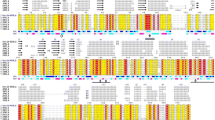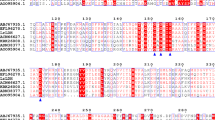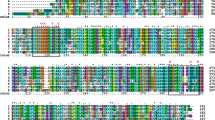Abstract
Although the de novo biosynthetic mechanism of 3-hydroxypropionic acid (3-HP) in glycerol-fermenting microorganisms is still unclear, the propanediol utilization protein (PduP) of Lactobacillus species has been suggested to be a key enzyme in this regard. To verify this hypothesis, a pduP gene from Lactobacillus reuteri was cloned and expressed, and the encoded protein was characterized. Recombinant L. reuteri PduP exhibited broad substrate specificity including 3-hydroxypropionaldehyde and utilized both NAD+ and NADP+ as a cofactor. Among various aldehyde substrates tested, the specific activity was highest for propionaldehyde, at pH 7.8 and 37 °C. The K m and V max values for propionaldehyde in the presence of NAD+ were 1.18 mM and 0.35 U mg−1, respectively. When L. reuteri pduP was overexpressed in Klebsiella pneumoniae, 3-HP production remarkably increased as compared to the wild-type strain (from 0.18 g L−1 to 0.72 g L−1) under shake-flask culture conditions, and the highest titer (1.38 g L−1 3-HP) was produced by the recombinant strain under batch fermentation conditions in a bioreactor. This is the first report stating the enzymatic properties of PduP protein and the probable role in biosynthesis of 3-HP in glycerol fermentation.





Similar content being viewed by others
References
Choi WJ (2008) Glycerol-based biorefinery for fuels and chemicals. Recent Pat Biotechnol 2:173–180
Della Pina C, Falletta E, Rossi M (2009) Oxidation of allyl alcohol in the presence of a gold catalyst: a route to 3-hydroxypropionic acid. ChemSusChem 2:57–58
Garai-Ibabe G, Ibarburu I, Berregi I, Claisse O, Lonvaud-Funel A, Irastorza A, Dueñas MT (2008) Glycerol metabolism and bitterness producing lactic acid bacteria in cider making. Int J Food Microbiol 121:253–261
Jiang X, Meng X, Xian M (2009) Biosynthetic pathways for 3-hydroxypropionic acid production. Appl Microbiol Biotechnol 82:995–1003
Leal NA, Havemann GD, Bobik TA (2003) PduP is a coenzyme-A-acylating propionaldehyde dehydrogenase associated with the polyhedral bodies involved in B12-dependent 1, 2-propanediol degradation by a Salmonella enterica serovar Typhimurium LT12. Arch Microbiol 180:353–361
Oh BR, Seo JW, Choi MH, Kim CH (2008) Optimization of culture conditions for 1, 3-propanediol production from crude glycerol by Klebsiella pneumoniae using response surface methodology. Biotechnol Bioprocess Eng 13:524–532
Raj SM, Rathnasingh C, Jo JE, Park S (2008) Production of 3-hydroxypropionic acid from glycerol by a novel recombinant Escherichia coli BL21 strain. Process Biochem 43:1440–1446
Rathnasingh C, Raj SM, Jo JE, Park S (2009) Development and evaluation of efficient recombinant Escherichia coli strains for the production of 3-hydroxypropionic acid from glycerol. Biotechnol Bioeng 104:729–739
Seo MY, Seo JW, Heo SY, Baek JO, Rairakhwada D, Oh BR, Seo PS, Choi MH, Kim CH (2009) Elimination of by-product formation during production of 1, 3-propanediol in Klebsiella pneumoniae by inactivation of glycerol oxidative pathway. Appl Microbiol Biotechnol 84:527–534
Suthers PF, Cameron DC (2001) Production of 3-hydroxypropionic acid in recombinant organisms. PCT WO 01-16346
Talarico TD, Casas IA, Cheng TC, Dobrodogsz WJ (1988) Production and isolation of reuterin, a growth inhibitor produced by Lactobacillus reuteri. Antimicrob Agents Chemother 32:1854–1858
Tang X, Tan Y, Zhu H, Zhao K, Shen W (2009) Microbial conversion of glycerol to 1, 3-propanediol by an engineered strain of Escherichia coli. Appl Environ Microbiol 75:1628–1634
van Maris AJA, Konings WN, van Dijken JP, Pronk JT (2004) Microbial export of lactic and 3-hydroxypropanoic acid: implications for industrial fermentation processes. Metab Eng 6:245–255
Werpy T, Holladay J, White J (2004) Top value-added chemicals from biomass. PNNL-14808, PNNL, Richland, WA
Yasuda S, Mukoyama M, Ilorikawa H, Toraya T, Morita H (2007) Process for producing 1,3-propanediol and/or 3-hydroxypropionic acid. United States Patent Application Publication US 2007/0148749 A1
Zhang GL, Xu XL, Li C, Ma BB (2009) Cloning, expression and reactivating characterization of glycerol dehydratase reactivation factor from Klebsiella pneumoniae XJPD-Li. World J Microbiol Biotechnol 25:1947–1953
Acknowledgments
The authors are very thankful to Prof. Sunghoon Park for generously supplying 3-hydroxypropionaldehyde. This work was supported by the Korea Research Foundation (KRF) grant funded by Korea Government (MEST) (Basic Researcher Promotion Program 2010-0015871).
Author information
Authors and Affiliations
Corresponding author
Electronic supplementary materials
Below is the link to the electronic supplementary material.
Supplementary Fig. 1
Schematic representation of the strategy used for construction of the recombinant plasmids pET-pduP (a) and pVOTLp (b). Abbreviations for restriction enzymes: B BamHI, N NcoI, Xb XbaI, X XhoI. (PPT 54 kb)
Supplementary Fig. 2
Amino acid alignment of L. reuteri PduP with respect to the enzymes of L. collinoides (CAD83152), Salmonella enterica (NP460996), and Klebsiella pneumoniae (YP001336844). The putative active sites cysteine residues are indicated in bold. (PPT 69 kb)
Rights and permissions
About this article
Cite this article
Luo, L.H., Seo, JW., Baek, JO. et al. Identification and characterization of the propanediol utilization protein PduP of Lactobacillus reuteri for 3-hydroxypropionic acid production from glycerol. Appl Microbiol Biotechnol 89, 697–703 (2011). https://doi.org/10.1007/s00253-010-2887-6
Received:
Revised:
Accepted:
Published:
Issue Date:
DOI: https://doi.org/10.1007/s00253-010-2887-6




